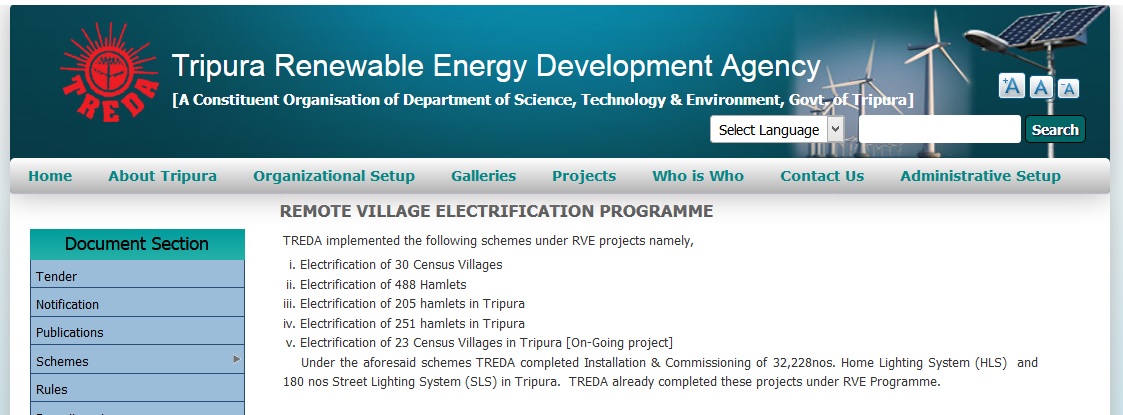treda.nic.in Remote Village Electrification Programme : Tripura Renewable Energy Development Agency
Organisation : Tripura Renewable Energy Development Agency.
Service Name : Remote Village Electrification Programme
Applicable States/ UTs : Tripura
Website : http://treda.nic.in/rve_programme
Terms & Conditions : https://www.statusin.in/uploads/38650-RVE.pdf
| Want to ask a question / comment on this post? Go to bottom of this page. |
|---|
TREDA Remote Village Electrification Programme
The objective of the Programme is electrification through renewable energy sources of those unelectrified remote census villages and remote unelectrified hamlets of electrified census villages where grid connectivity is either not feasible or not cost effective.
Related : eDistrict PRTC Permanent Resident of Tripura Certificate : www.statusin.in/18943.html
Project Design
Projects should intend to cover all the households in the village/hamlets, including those in the dalit bastis of the village, and creation of capability for availability of electricity as laid down in the National Electricity Policy, 2005, i.e., a minimum of 1 kWh/household/day.

However, if the state governments conclude after due consideration that the norm of 1 kWh/household/day is not achievable in a cost effective manner through various Renewable energy technologies, due to inadequate availability of the resources, then as a last resort they may decide to provide at least the basic lighting facilities through solar photovoltaic homelighting systems for each of the willing households in the village.
However, as per the National Rural Electrification policies of the Government, villages/hamlets using isolated lighting technologies like solar photovoltaic, may not be designated as “electrified”.
Eligibility of Villages/Hamlets
The current eligibility of villages/hamlets will be as follows :
i. All census unelectrified villages and their hamlets not covered under Rajiv Gandhi Grameen Vidyutikaran Yojana, as confirmed by REC.
ii. Unelectrified hamlets of electrified census villages having population of less than 100 subject to following certifications :
a. A certificate from the local revenue authorities that the hamlet is in permanent existence and certifying its total population, number of total households showing number of SC/ST households, number of BPL households if any, and the census code of the parent electrified village.
b. A certificate from the implementing agency that the hamlet is unelectrified and is not being taken up for electrification under state/Central programmes in near future.
Identification of Remote Villages/Hamlets
As stated at s.no.1 above, the support under the Programme will be provided to remote unelectrified census villages/remote unelectrified hamlets of electrified census villages, where grid connectivity is either not feasible or not cost effective.
The detailed eligibility conditions are given in para 5. The identification of such remote villages/hamlets has been broadly entrusted to the Rural Electrification Corporation.
The state governments should shortlist unelectrified villages/hamlets in their states which are not likely to be electrified through grid and send their names to MNRE for verification by REC.
The plan for electrification of remote villages/hamlets should ideally be an integral part of the plan for complete rural electrification in the state.
Implementation Mechanism
Following sequence of activities will be adopted for approval of financial support and implementation of projects :
i) Notification by the state government identifying nodal implementation agency for the Remote Village Electrification Programme, if not already notified.
ii) Preparation of Detailed Project Reports by the nodal implementing agency as per the enclosed format for the villages/hamlets to be taken up for electrification under the Programme; preparation of the plan for sustained operation of the projects including the revenue model proposed; and identification of appropriate village level bodies for actual implementation/ overseeing of the work, wherever necessary.
iii) Approval of the DPRs and the proposals by the state government including the commitment for balance of the funds in the format given at Annexure-II. Commitment of the state government for replacement of batteries in solar photovoltaic systems, whenever required, is also mandatory either as part of Annexure-II or separately.
iv) Submission of proposals to the Ministry for support along with the required documents.